One of the things that I enjoy most in consumable media is whenever the creator is able to immerse me into their world. I want to feel swept away into its universe. Whether it’s escapist fantasy, modern crime, historical fiction, as long as I’m able to put myself there, I’m in. Historically, the most natural medium for this kind of world-building has been books. The 20th Century development of the film industry brought another form of narrative expression. With the ever-improving animation and computing technology, video games have now entered the chat.
“Open-world” is a common term for video games such as The Legend of Zelda: Breath of the Wild, Elder Scrolls, and Fallout that give you hours of open-ended, player-driven gameplay. These are as much about playing around in the game as they are playing the game itself. Given that my love of board games has now dwarfed that of video games, it makes sense that I want to be able to recreate some of the joys I find in video gaming on the tabletop. While establishing a system with set rules and objectives is pretty universal in both analog and digital gaming, the concept of “open-world” is a much more difficult proposition on the table than the screen. By nature, board games involve some degree of abstraction. This makes it incredibly difficult to truly build a world, much less an open one.
Sleeping Gods, from the mind of designer, artist, publisher, and board game auteur Ryan Laukat, manages to not only pull it off, but permanently raise the bar for what board game story-telling can be. As in previous games like Above and Below and Near and Far, Laukat sets Sleeping Gods into his own fantasy universe that eschews traditional fantasy tropes like warrior/mage/paladin classes, orcs, goblins etc, for a unique blend of steampunk, mysticism, magic, and sometimes the just plain weird. You’re as likely to see a fast-talking robot as you are a friendly pig-man or tribe of angry minotaurs.
What separates Sleeping Gods from Laukat’s previous titles for me is the spirit of the game. While Near and Far and Above and Below, in particular, feel like board games with added story elements, Sleeping Gods is a story that sits atop a board game. In addition to the beautifully illustrated characters and world map, Sleeping Gods comes with a massive spiral-bound tome chock full of story passages that help build a wide, wonderful world worth diving into, full steam ahead. (Note: images are predominantly spoiler-free, coming from either the introductory tutorial scenario, or elements readily available at game start.)

Sleeping Gods starts off by dropping the players into the unknown. You and up to four players take command of Captain Odessa of the 1920’s era steamship Manticore, and its 8-person crew, as diverse as its namesake chimera. A voice from above informs you that the gods of this strange new world have brought you here. The only way to return home is to find a way to wake them by procuring magical items known as “totems.” No further instruction is given; you’ll need to figure out the rest on your own. In tabletop terms, this is represented by a ship miniature atop a spiral bound world map, split into regions, each containing numbered points of interest. In the game you’ll be sailing across this mystical realm, exploring those places. Each number corresponds to a passage in the story book.
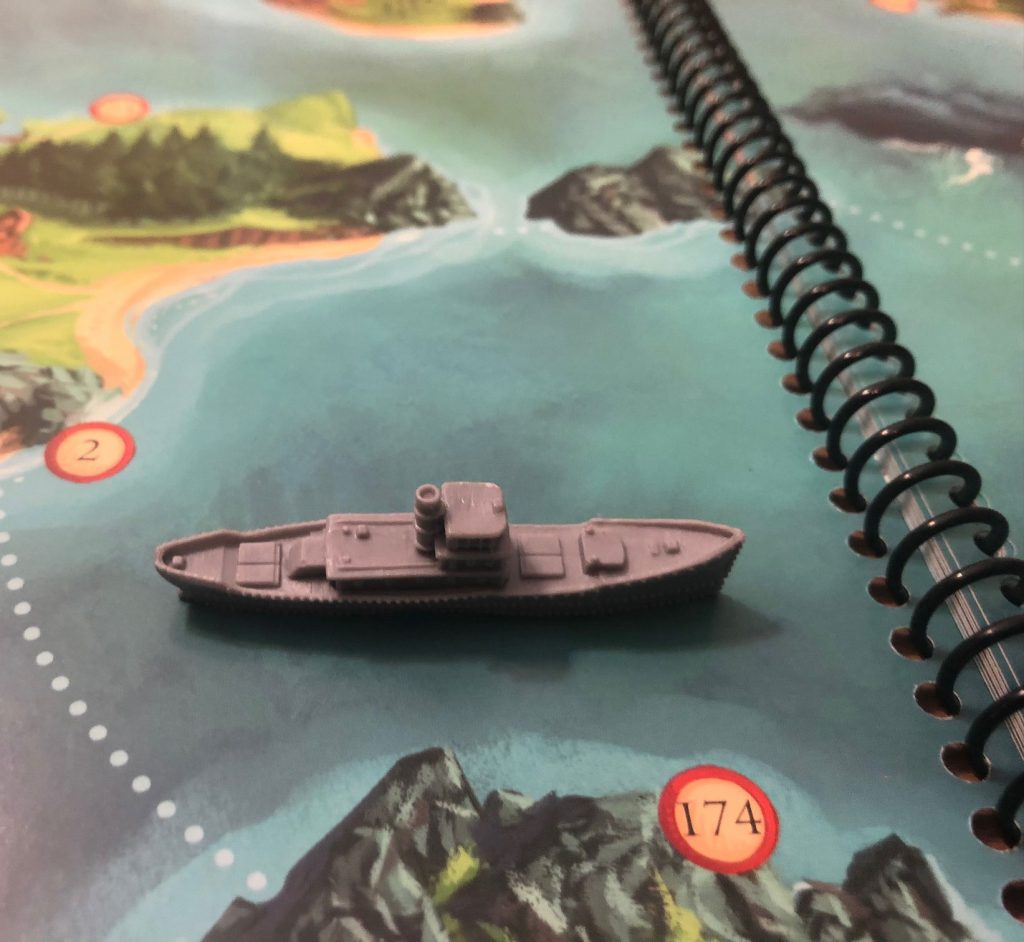
Most locations, in addition to a dollop of well-written story text, will provide you with choices to make. Additionally, some choices will be unavailable to you unless you have completed other parts of the game. Sleeping Gods expertly accomplishes this element of linear progression via the use of “keywords,” located on cards that you may receive throughout the game. Many of these keywords represent quests that you have been given by people along the way.
As a fictional example, you decide to explore a particularly verdant-looking stretch of land emblazoned with the number 32. Consulting the matching entry 32 in the storybook, you see a temple in a forest clearing with a giant door, on it a bronze lock. The book may say “If you have the keyword “KEY,” go to paragraph 32.3. Otherwise, read 32.1 It makes sense–you can’t open the locked door unless you have found the key.
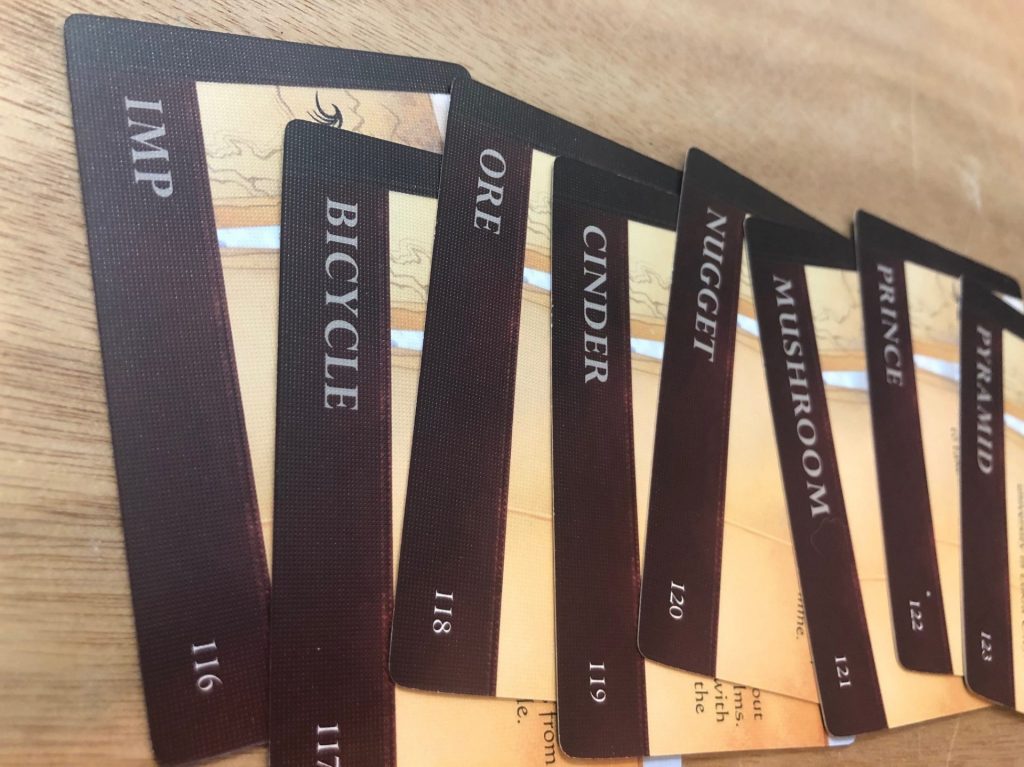
This relatively simple but genius system allows the game to both track the players progress, and propel the players’ choices. Where is the bronze key? Could it be over on the other side of the island? Maybe it’s back at the last port we stopped at, but we chose to talk to the shopkeeper instead of the blacksmith. Should we go back there? Or maybe we ignore this door for now and keep on searching for the FLOWER that the shopkeeper needed to make his healing potion.
The world of Sleeping Gods is massive, with hundreds of different story entries and 10+ double-sided maps. At the edges of your current map location is a number corresponding to a different map page. If you want to sail north, go for it. It’s this kind of player agency, along with the expert narrative, that lets Sleeping Gods create a player-driven, open world.
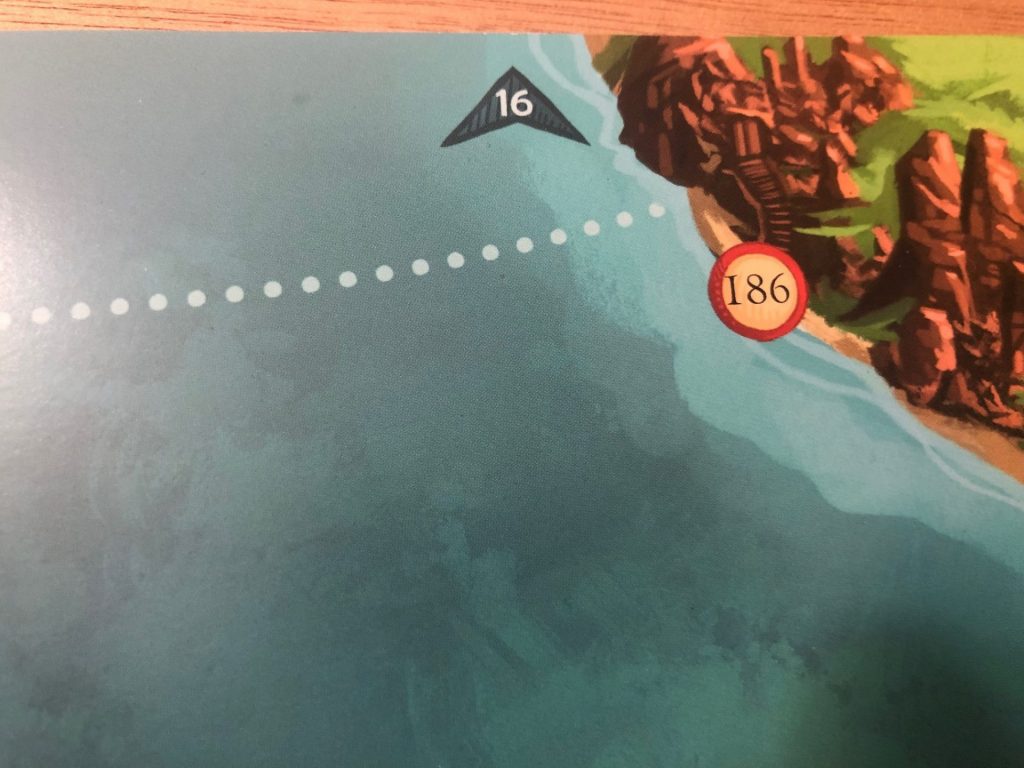
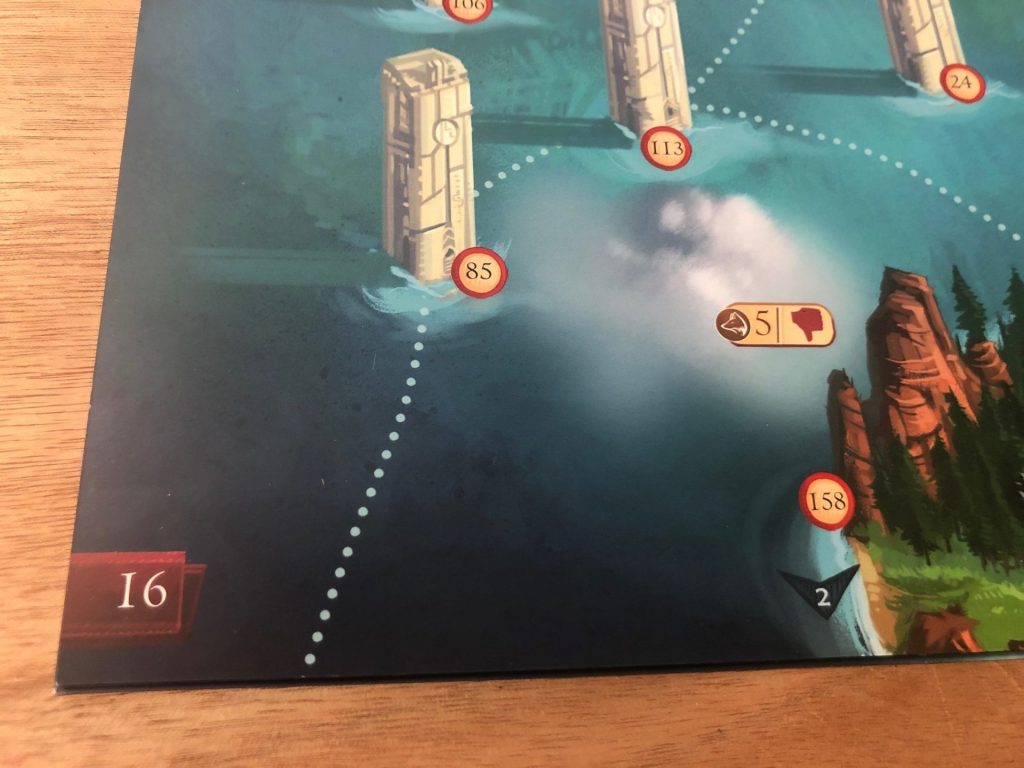
But don’t write the board game off as little more than a group story-telling session. The underlying board game that carries the story along is solid, with clever, innovative, and often challenging mechanics. The gameplay, like the world, is pretty large in scope, so I’ll just cover the basics.
Gameplay
A turn is divided into three primary phases:
- Ship Action: Move the ship action figure to one of the five rooms on the ship board and apply the effect. You must move the figure to a new room each turn. No repeating your favorite room two turns in a row.
- Event: Draw an event card from the event deck and resolve the effects. The event deck may present you with a choice, a challenge, or simply an effect. (More on challenges later.) Important: the game will end after your third time through the event deck.
- Perform two actions: This is the bulk of the game. The available actions are:
- Sail – move your ship around the board
- Explore – select a numbered point of interest in your region and read the associated story portion
- Market (if available)– Draw 7 cards from the market deck. Buy to your heart’s (and wallet’s) content.
- Port (if available) Spend gained XP to get character-specific level-up cards, repair the ship, rest up at the inn, or visit a healer. (Those last three will cost you. Adventuring ain’t free.)
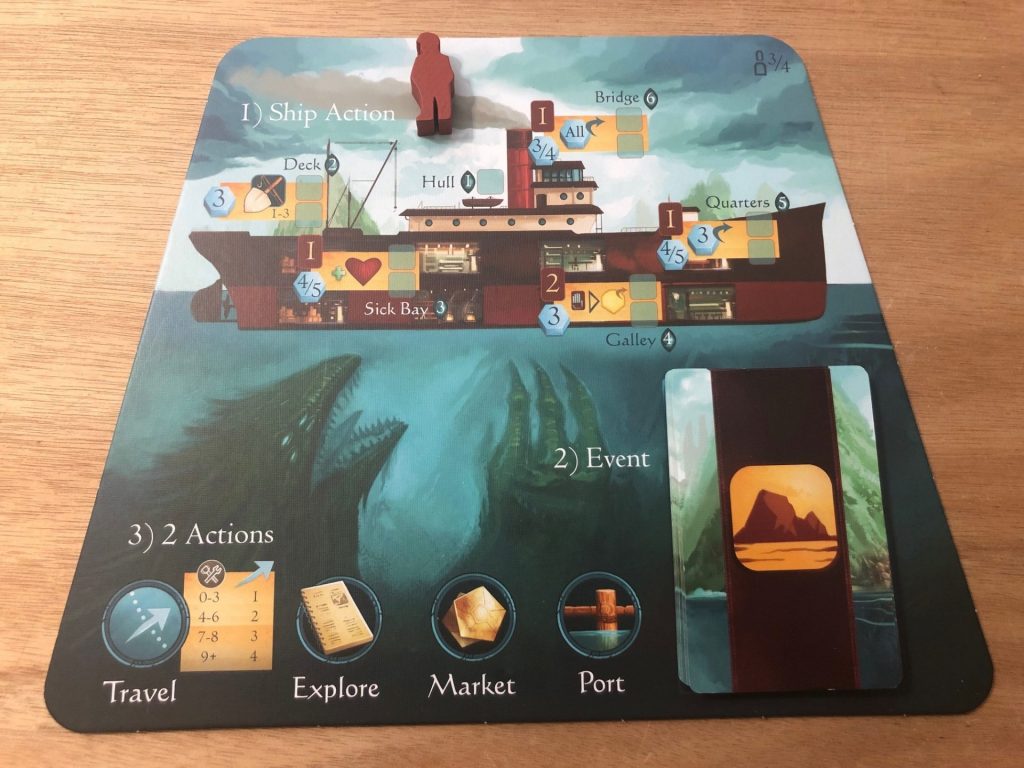
Many of the events, actions, and choices will require you to perform stat-based challenges. It may say: STRENGTH 9. This means that you must pass a strength challenge with a value of 9 or better. Sleeping Gods uses a deck of numbered fate cards instead of dice to resolve. Cards are valued from 1 to 6. Each character also has stat values that correspond to the specific challenge requests. On a challenge, players must decide before flipping a fate card if they want to use a particular character for the challenge, adding their corresponding stats to the result. The outcome of failing a challenge varies. It may have negative consequences, direct you to read a different passage, or simply have no effect at all.
The twist to this card-based resolution is that you’re drawing from the same deck that has skills and attributes that can boost your stats. This leads to some interesting decision space. Do you want to hold onto that nifty Rapid Strike that gives you a +1 in Strength plus a special ability, or discard it to the fate deck because it has a value of 6?

One other key mechanic in the game is the management of action tokens. These can be used to do a number of things throughout the game, primarily used on cards or character abilities that help you out. The game comes with loads of different people, items, and skill cards of various abilities. For instance you could spend a token on a special item to boost your skills, engage Gloria to draw more cards, or even whip up some delicious pancakes, using available resources gathered along the way.
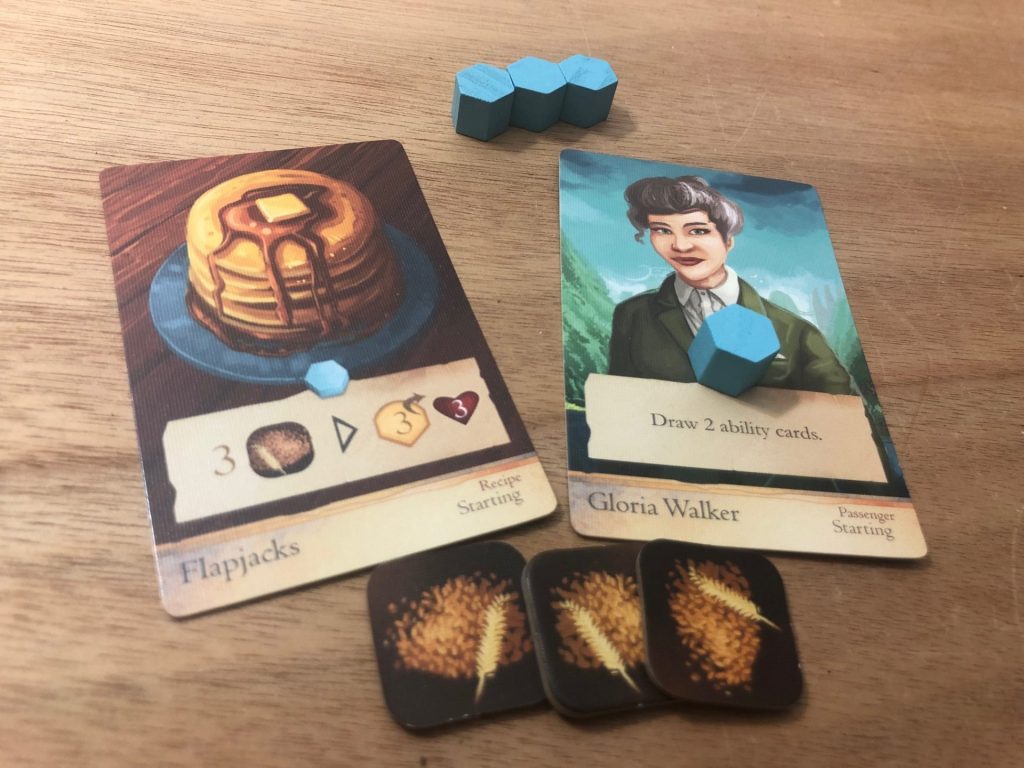
Additionally, each character has some special abilities that also require action tokens. Having spare action tokens in a pinch can mean the difference between successfully reaching your goals or getting metaphorically punched in the face.
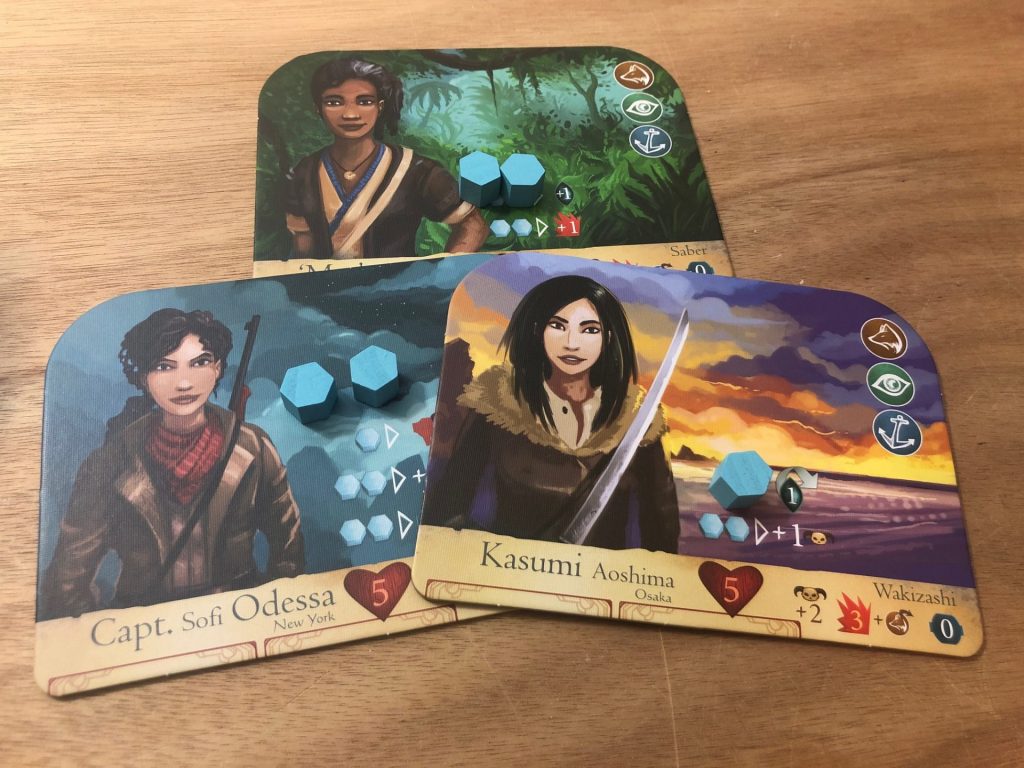
Speaking of punching, let’s talk a bit about the combat system in Sleeping Gods. In your adventures, you will inevitably chance upon some baddies that may not share your desire for peaceful discourse. Sometimes that big stick you’re walking softly with just needs a good workout. Or maybe an NPC is stubbornly refusing to give up their goodies and you decide that smacking them is the best way to remind them that you are indeed the protagonists.
The combat system in Sleeping Gods is really clever, something I haven’t seen before. It combines traditional stat-crunching with spatial-logistical puzzles with varied levels of difficulty. Enemies are represented by cards, each with a 3×3 grid containing various potential combinations of hearts, skill icons, and blank spaces. When directed to take up arms for a tangling tussle, you’ll draw the specifically numbered enemy cards from the ridiculously sized enemy deck, then randomly lay them out side by side.
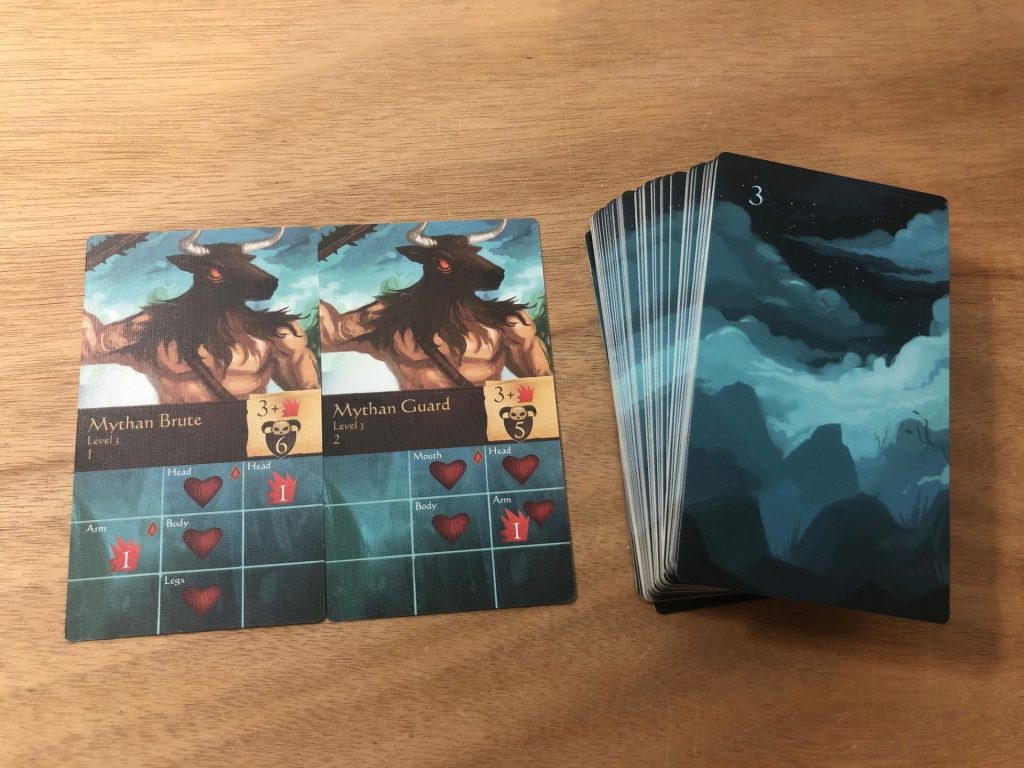
Players will get four combat actions per round, taking turns activating one of their characters, with the captain being available to all. When activated, characters will perform an attack using whichever weapon they have available. To even land a hit, they will need a dexterity value higher than the monsters’ shield, via a combo of their natural abilities, any equippables, and a fate draw. If successful, they then deal damage according to how strong that weapon is. This is represented by dropping a damage token over the particular grid square you’re aiming for. Once all of the enemy’s hearts are covered up, you are victorious.
However, damage dealt can only go orthogonally and you can’t go through an empty space or one that has already been filled. Because of this spatial restriction, you’ll often need multiple swipes to get all those icons covered.. After each hit the monsters will retaliate, dealing out damage equal to their attack power. (plus any additional bonuses on their grid) The attacking character then must take damage of their own, minus any defenses they may have from their weapon, items, or bonuses.
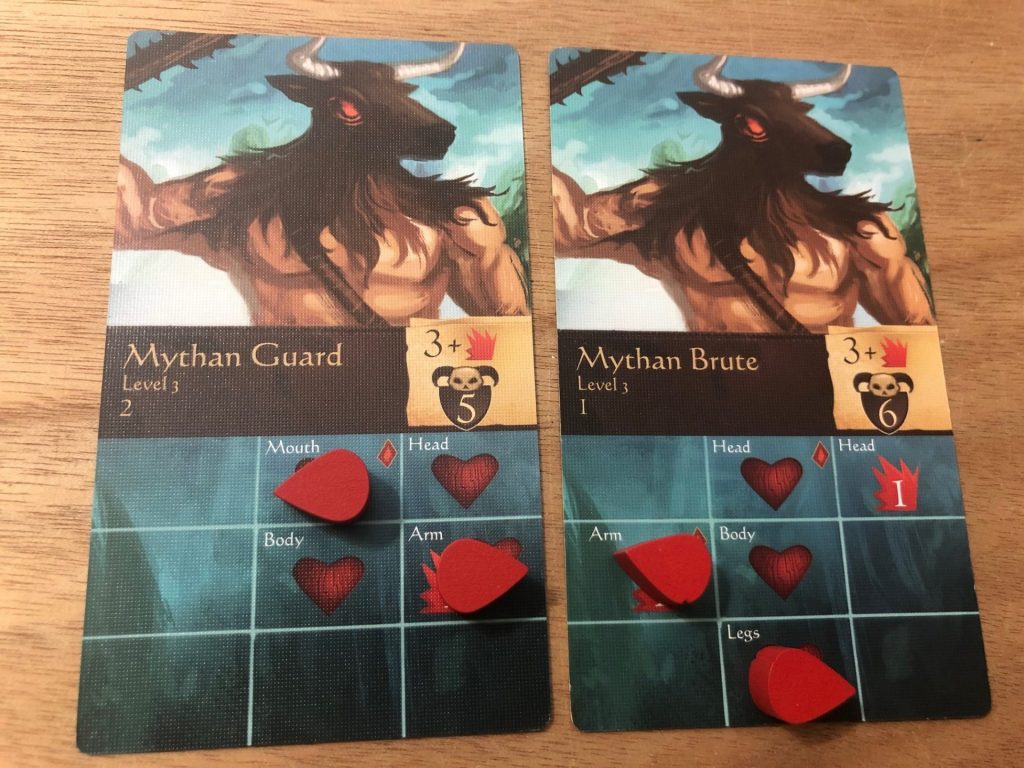
After all four combat actions have been taken, the monsters will take a turn. Players can defend with a character of their choice. Combat action tokens are refreshed, rinse and repeat until all the baddies have been sufficiently stomped.
There are a number of status ailments monsters can apply that I won’t go into, but I did want to mention one particularly cool combat element: synergy tokens. Each character has a synergy token with a unique special ability. Some of the combat grid spaces have little red diamonds. Whenever one of these diamond squares are covered up, it activates the attacking character’s synergy token. They can then pass that token to another character who can use the special ability on their next go, returning it to its original owner after use. Characters can’t use their own token. It takes two to synergistically tango, after all.
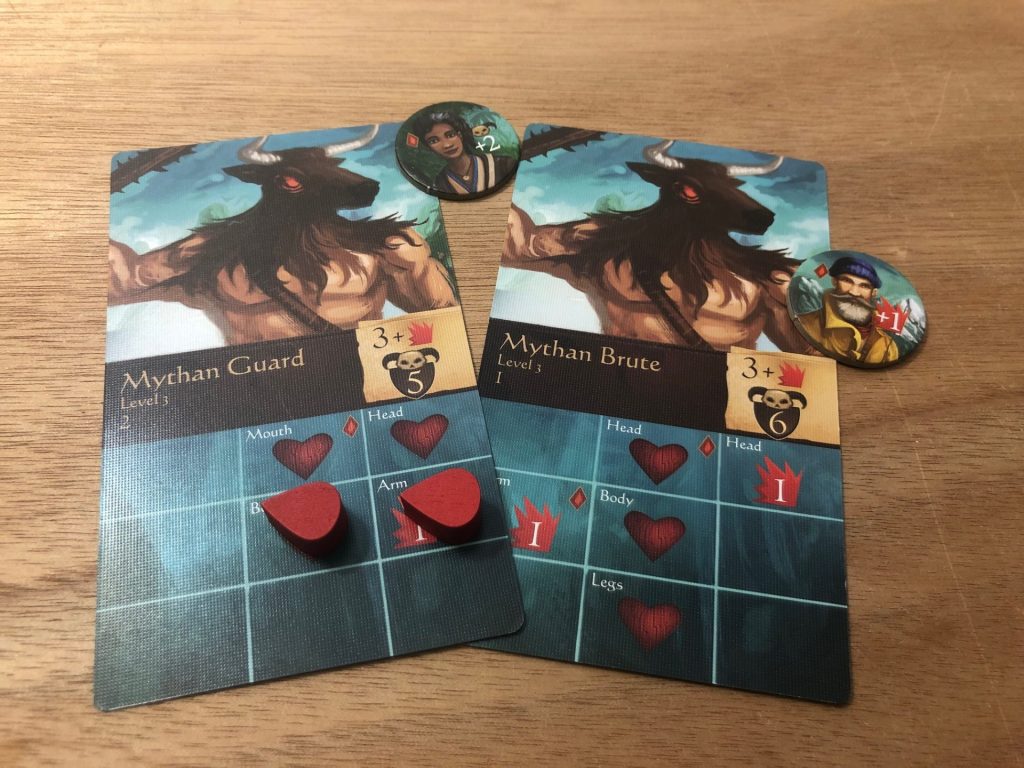
The use of synergy tokens adds an additional element to the combat puzzle. You’ll be planning ahead for future turns, saying things like:
Okay, if I hit them on the top corner and deal two damage going left, it’ll trigger my +2 dexterity token, which I’ll give to the next attacker who needs that dexterity boost. They’ll go top center and hit the other baddie, trigger the next diamond and give their +1 damage token to the third character, who can finish him off before he hits back.
The elements of cooperation and synergy-planning add another cherry on top of the fully whipped combat cream, creating a delightful puzzle that when overcome feels like a true group victory.

Final Thoughts
There is so much to love about Sleeping Gods, from the beautiful art, stellar production, incredible story-telling, and the overall “how in the world did they do that” cohesiveness of the dozens of narrative story-arcs. The world is inviting, and the mechanics are streamlined enough to not get in the game’s way. The game scope is truly massive. I’ve sunk at least 40 hours into this world, yet astoundingly I still have so much left to discover. I’ve never even sailed east from the starting point. Technically speaking, the primary narrative goal is to find the totems, but it’s just as rewarding to get pleasantly preoccupied by the plethora of quests and adventures. Finding the totems isn’t even necessarily a requirement. There are 75 total totems to find in the Sleeping Gods universe.I’ve played two full campaigns of this game and so far have gotten seven, with a pretty good idea where two more are. Make no mistake, though. If you are someone with a singularly goal-oriented mindset dead set on finding totems before time runs out, you’ll find some. I just happen to enjoy piddling about exploring every location I find, picking up interesting items, engaging adventures, even new companions along the way.
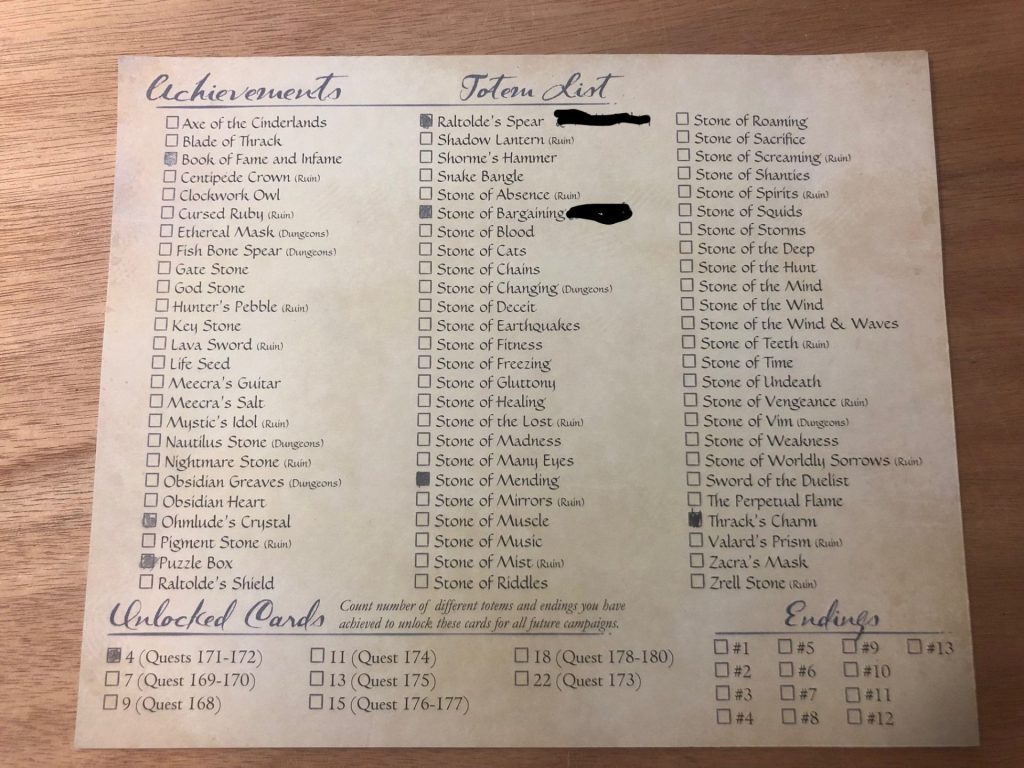
Sleeping Gods is just amazing. It swiftly sailed on its whimsical winds of discovery into my top games of all time. I would even go as far to say that this is the definitive exploration game. Sleeping Gods is just a paragon of world-building, a master-class in story-telling, and quite simply, a masterpiece. I cannot recommend this game highly enough and can’t wait to dive back into its mystical, magical, whimsical world.


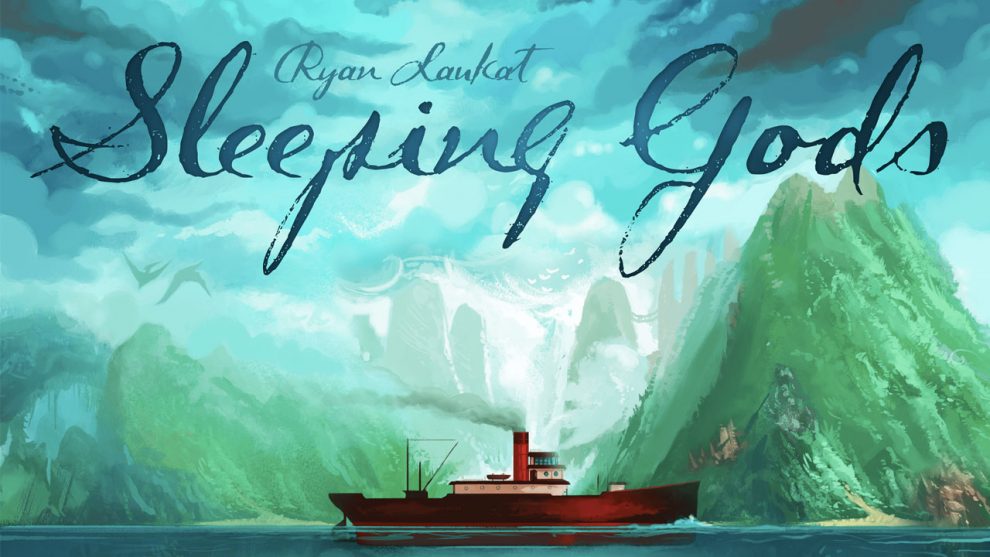

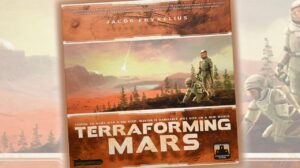







Add Comment